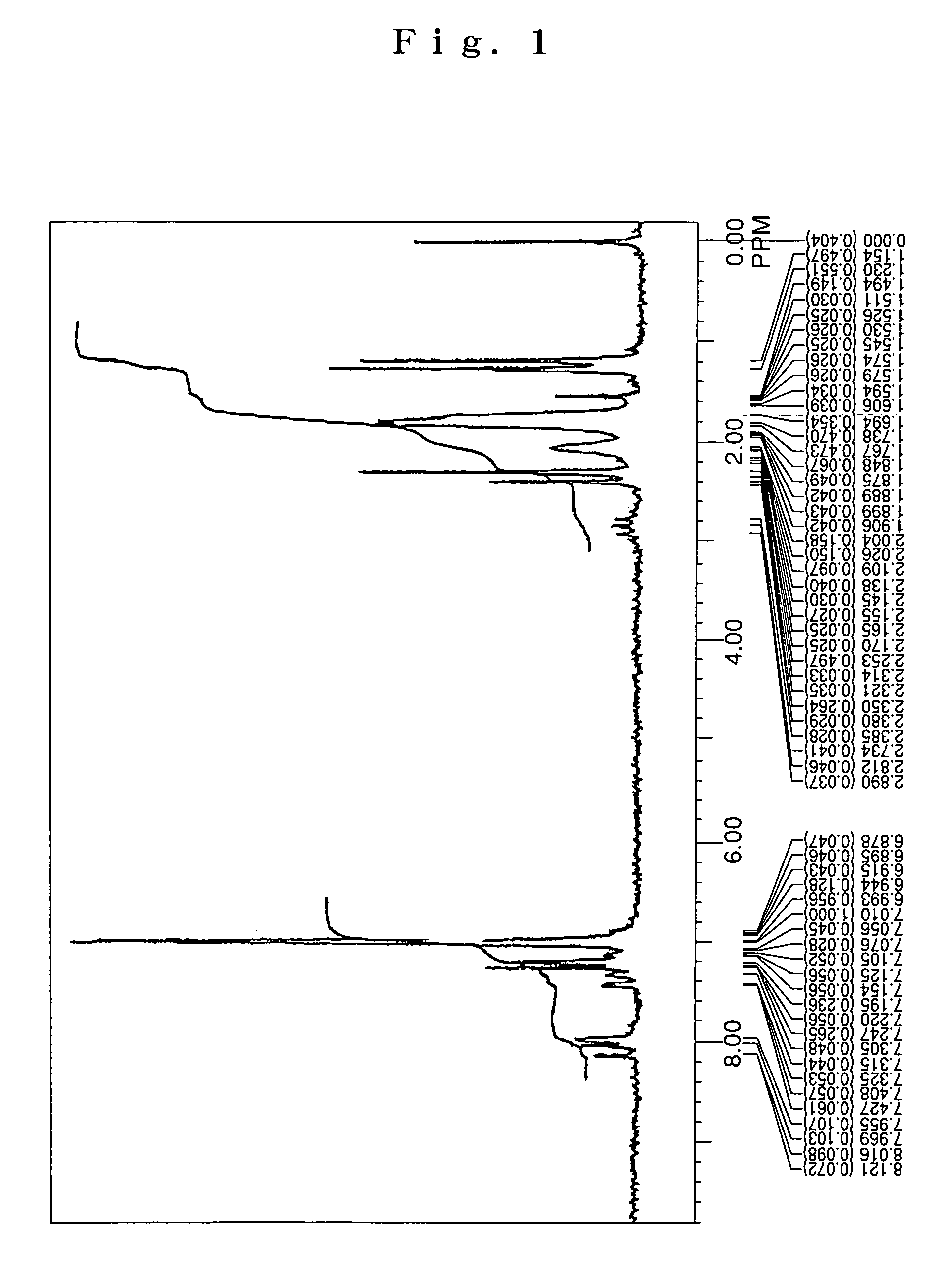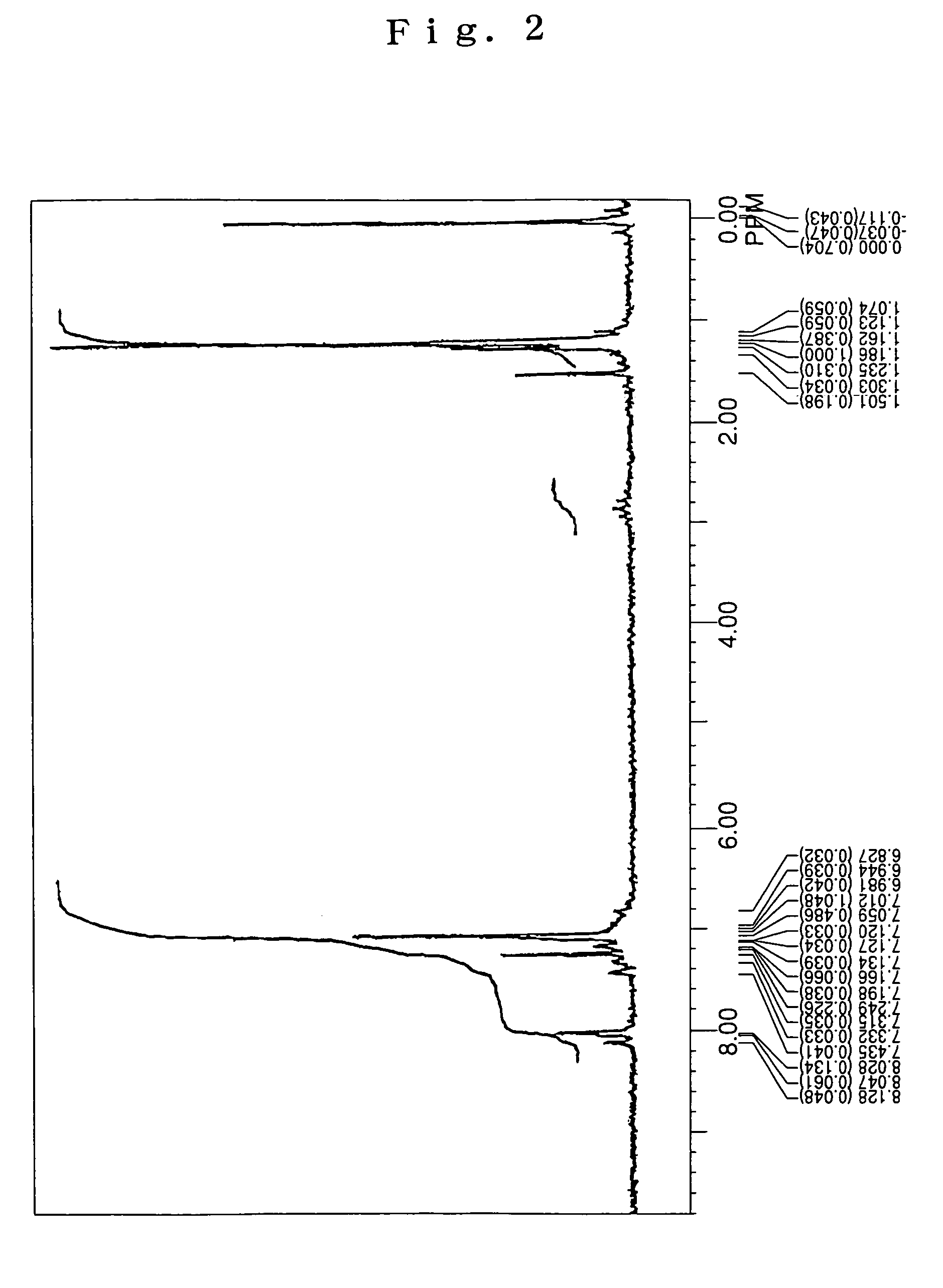Aromatic amine derivative and organic electroluminescent element employing the same
a technology of aromatic amine and organic electroluminescence, which is applied in the direction of organic semiconductor devices, other domestic articles, natural mineral layered products, etc., can solve the problems of unsatisfactory performance of light emitting materials, low light emission efficiency, and inability to use, and achieve high light emission efficiency, long life, and high luminance of light emitted
- Summary
- Abstract
- Description
- Claims
- Application Information
AI Technical Summary
Benefits of technology
Problems solved by technology
Method used
Image
Examples
synthesis example 1
Synthesis of Compound (6)
[0079]Under an argon flow, 6.0 g (10 mmol) of 2,6-di(1-adamantyl)anthracene, 5.6 g (25 mmol) of 4-isopropylphenyl-p-tolylamine, 0.03 g (1.5 mol %) of palladium acetate, 0.06 g (3 mol %) of tri-t-butyl phosphine, 2.4 g (25 mmol) of t-butoxy sodium and 100 mL of dried toluene were charged into a 300 mL three-necked flask equipped with a condenser tube, and then stirred under heating at 100° C. over night. After completion of the reaction, the precipitated crystals were separated from the reaction solution by filtration, and then washed with 50 mL of toluene and 100 mL of methanol, thereby obtaining 7.2 g of a light-yellow powder. The thus obtained powder was subjected to NMR spectrum analysis (FIG. 1) and FD-MS (field desorption mass spectrum analysis). As a result, the reaction product was identified as the compound (6) (yield: 82%).
[0080]Meanwhile, the NMR spectrum was measured by Fourier-transform NMR analyzer “R-1900” (90 MHz) available from Hitachi Limite...
synthesis example 2
Synthesis of Compound (7)
[0081]Under an argon flow, 4.5 g (10 mmol) of 2,6-di-t-butyl anthracene, 5.2 g (25 mmol) of 4-isobutyl diphenyl amine, 0.03 g (1.5 mol %) of palladium acetate, 0.06 g (3 mol %) of tri-t-butyl phosphine, 2.4 g (25 mmol) of t-butoxy sodium and 100 mL of dried toluene were charged into a 300 mL three-necked flask equipped with a condenser tube, and then stirred under heating at 100° C. over night. After completion of the reaction, the precipitated crystals were separated from the reaction solution by filtration, and then washed with 50 mL of toluene and 100 mL of methanol, thereby obtaining 6.0 g of a light-yellow powder. The thus obtained powder was subjected to NMR spectrum analysis (FIG. 2) and FD-MS. As a result, the reaction product was identified as the compound (7) (yield: 85%). Meanwhile, the NMR spectrum was measured under the same conditions as described in SYNTHESIS EXAMPLE 1.
synthesis example 3
Synthesis of Compound (8)
[0082]Under an argon flow, 4.5 g (10 mmol) of 2,6-di-t-butyl anthracene, 4.9 g (25 mmol) of p,p′-ditolylamine, 0.03 g (1.5 mol %) of palladium acetate, 0.06 g (3 mol %) of tri-t-butyl phosphine, 2.4 g (25 mmol) of t-butoxy sodium and 100 mL of dried toluene were charged into a 300 mL three-necked flask equipped with a condenser tube, and then stirred under heating at 100° C. over night. After completion of the reaction, the precipitated crystals were separated from the reaction solution by filtration, and then washed with 50 mL of toluene and 100 mL of methanol, thereby obtaining 6.3 g of a light-yellow powder. The thus obtained powder was subjected to NMR spectrum analysis (FIG. 3) and FD-MS. As a result, the reaction product was identified as the compound (8) (yield: 93%). Meanwhile, the NMR spectrum was measured under the same conditions as described in SYNTHESIS EXAMPLE 1.
PUM
| Property | Measurement | Unit |
|---|---|---|
| work function | aaaaa | aaaaa |
| light transmittance | aaaaa | aaaaa |
| thickness | aaaaa | aaaaa |
Abstract
Description
Claims
Application Information
 Login to View More
Login to View More - R&D
- Intellectual Property
- Life Sciences
- Materials
- Tech Scout
- Unparalleled Data Quality
- Higher Quality Content
- 60% Fewer Hallucinations
Browse by: Latest US Patents, China's latest patents, Technical Efficacy Thesaurus, Application Domain, Technology Topic, Popular Technical Reports.
© 2025 PatSnap. All rights reserved.Legal|Privacy policy|Modern Slavery Act Transparency Statement|Sitemap|About US| Contact US: help@patsnap.com



